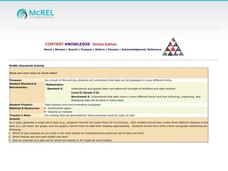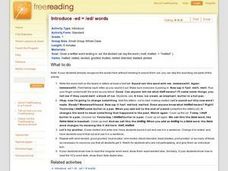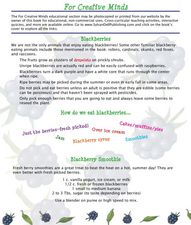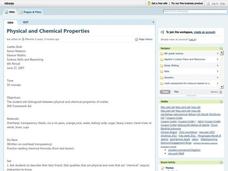Curated OER
Estimation
Fourth graders view a variety of rice products and calculate their cost. In this rice math instructional activity, 4th graders estimate cost and multiply to find 8 of each item. Students estimate using different amounts of rice...
Curated OER
Data Display
Students explore different ways to display data. In this statistics lesson, students create pie charts, bar graphs and line graphs to show data. Students then write a paragraph discussing which types of graphs are helpful for different...
Curated OER
Right to Equal Opportunity
Students investigate the concept of equal opportunity in school. In this equal opportunity instructional activity, students participate in a discussion about the fairness of certain situations in school. They listen to a story entitled,...
Curated OER
Introduce -ed =- /ed/ words
First graders practice spelling 'ed' ending words. For this suffixes lesson, 1st graders practice saying and spelling words with -ed suffixes.
Curated OER
Kindergarten Class Favorites
Students discuss their favorite foods, a list of four favorite food are compiled on the board or a chart. They each vote for their favorite food and the data is entered onto a spread sheet and a graph is created while the students watch...
Curated OER
Classification
Students investigate how different types of food can be classified then counted. In this sorting, arranging, and classifying lesson plan, students explore how to group foods based on commonalities. Students are asked four questions which...
Cornell University
Unknown Powders
Create a little scientific magic within your classroom! Learners mix powders and liquids and identify chemical reactions. Based on the reactions, individuals determine the identity of various powders.
Southern Nevada Regional Professional Development Program
Pardon Me, Your Modifier is Dangling
Lost! (or misplaced) a modifier. Last seen dangling at the end of a sentence! Reward offered! To underscore the humor, class members are each given a sample sentence to illustrate (A woman passed by, leading a Springer Spaniel, in a...
Curated OER
Wacky Water Critters
Students visit a local creek or stream. They collect water samples from the creek and observe and sort the "water critters" they find in the sample, observing smaller organisms under a microscope if necessary. They identify each organism...
Curated OER
Beat the Heat
First graders are introduced to the concept of vowel digraphs. They identify the digraph /ea/ in written and spoken language. After a brief discussion, 1st graders apply the rule for identifying and spelling words containing the /ea/...
Curated OER
It Counts
Students explore how numbers can identify objects. In this math lesson, students determine how numbers are used to describe objects used in quantitative data collection.
Curated OER
Blackberries
Students read and answer questions about other animals that like blackberries besides humans. In this blackberries lesson plan, students read about what animals like to eat blackberries and what they do for them.
Curated OER
A Birthday Basket for Tia
Students practice reading and math skills using technology. In this main idea lesson, students retell the important events of A Birthday for Tia in sequence using Kid Pix. Students create a bar graph using The Graph Club...
Curated OER
Physical and Chemical Properties
Students study the difference between physical and chemical properties. They also discuss changes in matter, known as physical and chemical changes. They observe and discuss several demonstrations of both physical and chemical changes
Curated OER
Applied Science - Science and Math Pre Lab
Students explore human senses. In this applied Science activity, students utilize their senses to distinguish various objects. Students explain their descriptions.
Curated OER
Personal Clay Box
Seventh graders discover how to assemble and finish a lidded box-like form from slabs of clay between soft and leather hard. They gain an appreciation for ceramic art.
Curated OER
Mud Puddles And Bubbles
Students create muddy foot prints, "paint" with their feet, and explore the uses of bubble mix in this three-part lesson for the early-elementary classroom. The three activities can be used separately, or adapted depending on the...
Curated OER
How My Parents Learned to Eat
Students identify popular foods in Japan. In this social studies lesson plan, students read the story How My Parents Learned to Eat and discuss ways that the Japanese eat their food. Students research popular foods in Japan.
Curated OER
Agriculture Cares for the World
Students explore world geography by analyzing agriculture. In this dietary habits lesson, students discuss the role parents play in their children's diet and where the food comes from. Students write agricultural research paragraphs and...
Curated OER
Taste Test
Third graders practice creating bar graphs by conducting a taste test. In this graphing lesson, 3rd graders taste several different brands of peanut butter and discuss among their classmates which tastes better. Students...
Curated OER
Two-Dimensional and Three-Dimensional Shapes
First graders explore 2-dimensional and 3-dimensional shapes. In this geometry lesson, 1st graders examine the attributes of 2 -dimensional and 3-dimensional shapes. They also create the shapes as they build models. This lesson...
Curated OER
Food Dictionary - Harvest Festival
Students explore healthy foods and dictionary organization. Students create a list of healthy foods. They construct their own food dictionary, with illustrations. Students model how a dictionary page should be filled with a picture,...
Curated OER
Today is Monday Lesson Plan
Pupils practice the days of the week. In this week lesson, students listen to the story "Today is Monday" and discuss what food matches with each day of the week. The pupils put food cards out to match the story and draw these on a blank...
Curated OER
The Story of Milk
Students listen while the teacher reads the background information. They discuss the main points of the reading. Students color, cut out pictures, and glue the pictures above appropriate sentences to illustrate the correct sequence in...

























